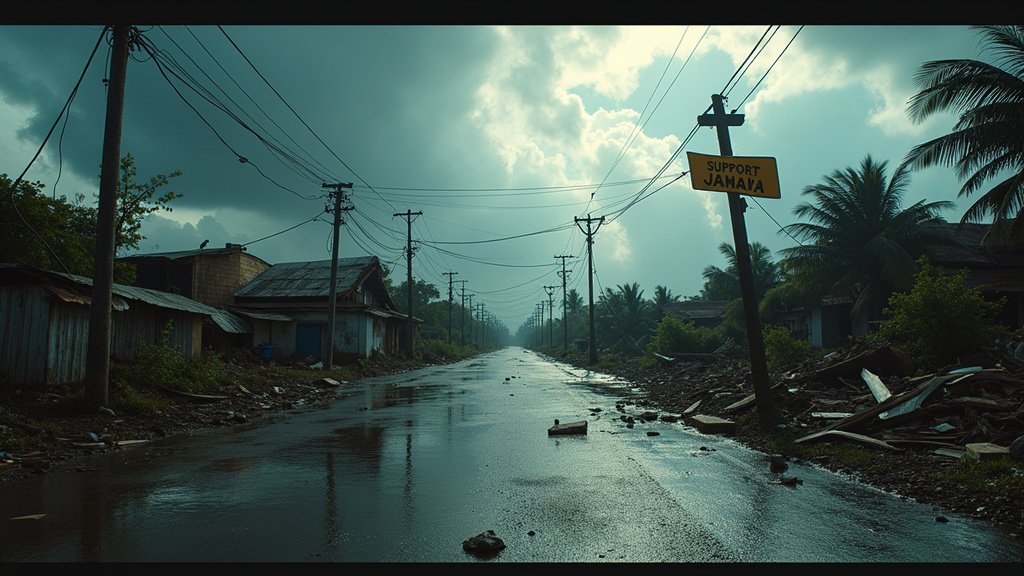KINGSTON, Jamaica – In an event described by officials as the “storm of the century,” Category 5 Hurricane Melissa made landfall on the southwestern coast of Jamaica, unleashing catastrophic winds, torrential rains, and life-threatening storm surges. The historic Hurricane Melissa Jamaica, one of the most powerful Atlantic storms on record, has left a trail of widespread destruction across the island nation, resulting in multiple fatalities and plunging its economy into severe crisis after this catastrophic Jamaica hurricane event.
The Fury of Hurricane Melissa Jamaica: A Record-Breaking Landfall
Hurricane Melissa slammed into Jamaica with sustained winds of 185 mph, marking the strongest hurricane to ever make landfall in the island’s recorded history. The storm’s intensity, measured by its central pressure, tied records for the strongest Atlantic hurricane landfall on record, alongside the 1935 Labor Day Hurricane and Hurricane Dorian in 2019. Forecasters warned of “total structural failure” in its path, a grim prediction that has sadly materialized in many communities following the Hurricane Melissa Jamaica landfall.
A Landscape of Ruin from Hurricane Melissa Jamaica
The impact of Hurricane Melissa has been devastating, with catastrophic winds tearing roofs off buildings and boulders tumbling into roads. Southwestern Jamaica bore the initial brunt, experiencing life-threatening storm surges of up to 13 feet and severe flooding. The island’s infrastructure has been severely compromised, with numerous reports of flooded and destroyed roads and bridges, isolating communities and hindering rescue efforts. Landslides were a significant hazard, particularly in mountainous areas. Power outages have crippled hundreds of thousands, exacerbating the challenges faced by residents. The parish of St. Elizabeth, known as the island’s breadbasket, has suffered extensive Jamaica damage, threatening the nation’s food supply after Hurricane Melissa Jamaica.
Human Toll and Immediate Response to Hurricane Melissa Jamaica
The human cost of Hurricane Melissa is mounting, with at least seven deaths reported across the northern Caribbean, including three in Jamaica attributed to storm preparations. Search and rescue operations are underway, but hampered by the extensive damage to infrastructure following the Hurricane Melissa Jamaica impact. As the storm approached, mandatory evacuation orders were issued for vulnerable areas, and approximately 6,000 people sought refuge in shelters nationwide. Government officials, including Prime Minister Andrew Holness and Minister Desmond McKenzie, urged citizens to heed warnings and prioritize safety. International humanitarian organizations, including the International Organization for Migration (IOM), the World Food Programme (WFP), and Project HOPE, have mobilized to provide essential aid, including relief supplies, medical assistance, and shelter support. The Pan American Health Organization (PAHO) is also coordinating health preparedness and response efforts, anticipating disruptions to healthcare delivery and potential outbreaks due to this natural disaster Jamaica.
Economic Shockwaves of Hurricane Melissa Jamaica Threaten Recovery
The economic fallout from Hurricane Melissa is projected to be staggering, with early estimates suggesting potential losses for Jamaica could reach up to US$14 billion, an amount equivalent to nearly three-quarters of its annual GDP, leading to a severe economic crisis Jamaica faces. Analysts warn that industry losses could exceed $5 billion, with potential impacts ranging from a deep recession and widespread unemployment to severe strain on local banks and insurers. The vital tourism sector is also expected to face significant long-term damage and disruption from Hurricane Melissa Jamaica. Compounding these challenges is Jamaica’s relatively low insurance penetration, creating a substantial protection gap that will strain public borrowing for rebuilding efforts. The country’s parametric catastrophe bond was also likely triggered, providing some financial relief. This news highlights the vulnerability of the island’s business sector to extreme weather events like the Hurricane Melissa Jamaica.
Regional Ramifications and the Path Ahead for Jamaica Post-Hurricane Melissa
Following its destructive passage through Jamaica, Hurricane Melissa continued its path towards Cuba, where large-scale evacuations were underway, and then towards the Bahamas. The slow-moving nature of the storm prolonged its impact, increasing risks of landslides and extended business disruption. Recovery operations have commenced, with authorities and international partners working to assess damage and begin the arduous process of rebuilding affected communities. The Jamaican government has launched a dedicated website, Support Jamaica, to aid in relief efforts and collect donations for the long road ahead following the Hurricane Melissa Jamaica disaster.
The immediate aftermath of Hurricane Melissa in Jamaica underscores the immense challenges faced by Caribbean nations confronting increasingly intense climate-related disasters. The scale of destruction and the projected economic impact signal a profound test for the island’s resilience and recovery capabilities after Hurricane Melissa Jamaica. This unfolding news story serves as a stark reminder of the devastating power of nature and the urgent need for continued global cooperation in disaster preparedness and climate action following this unprecedented Jamaica hurricane.

